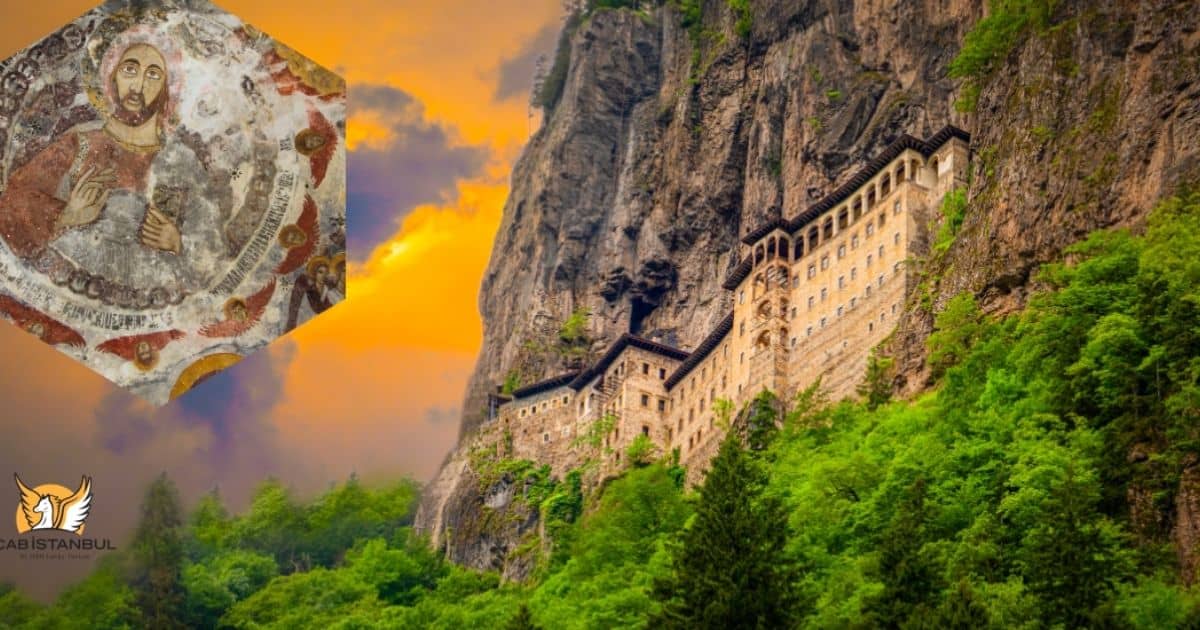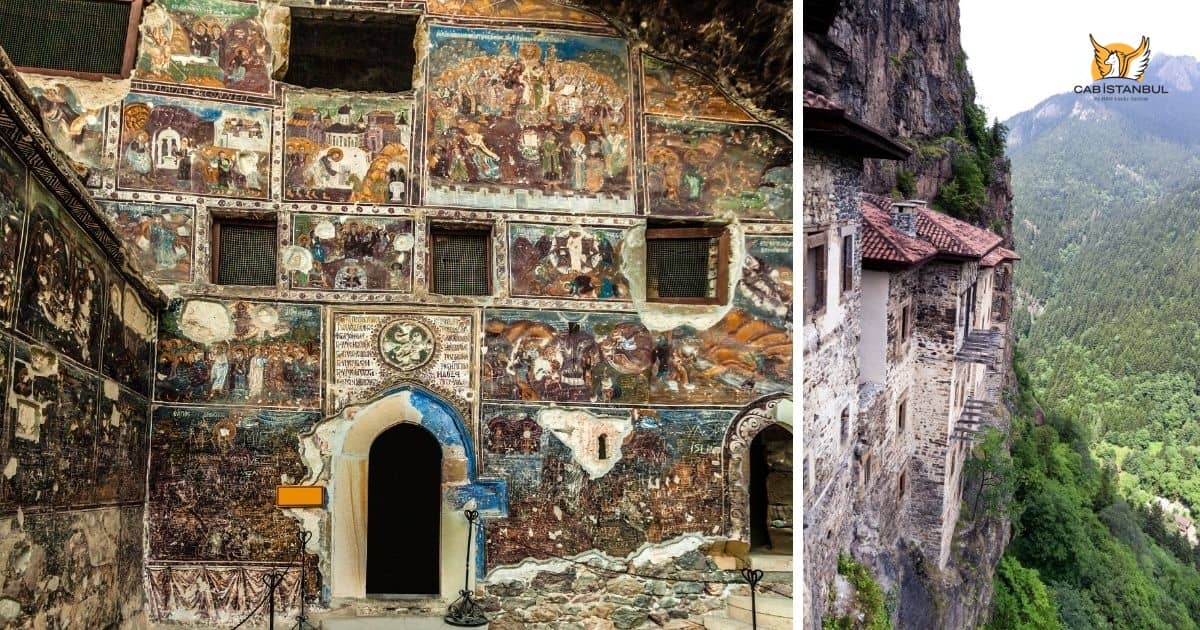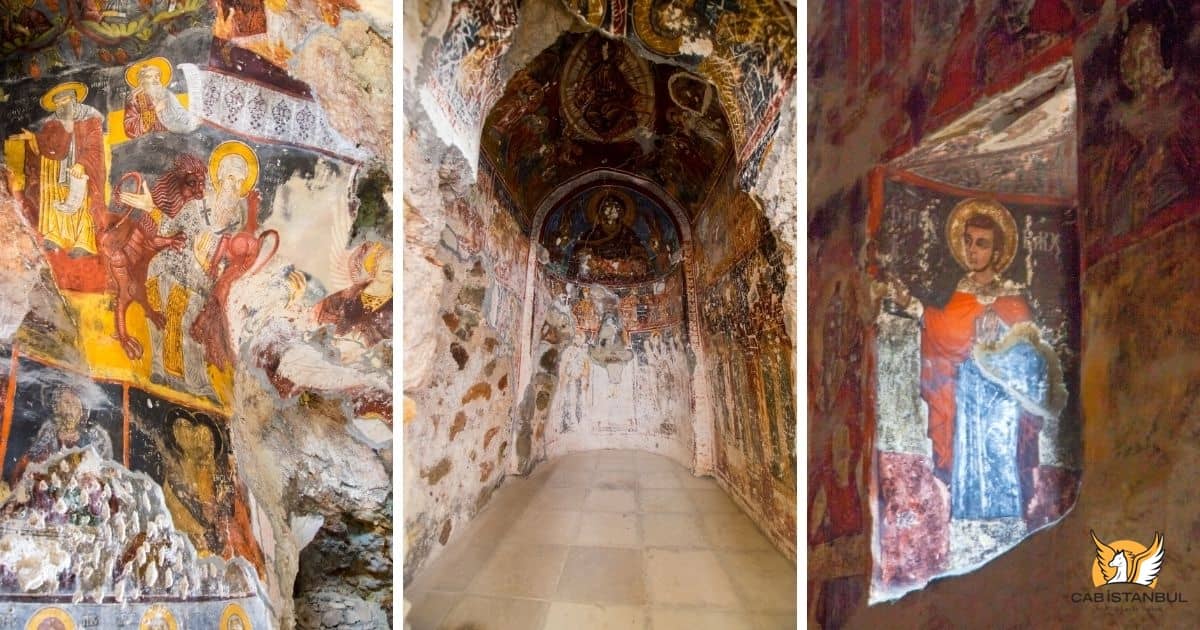Sumela Monastery -Trabzon
2026-01-20

Monastery Of The Virgin Mary: Sumela
Sumela Monastery (Sümela Manastırı), dramatically carved into the sheer cliffs of the Pontic Mountains in Trabzon’s Maçka district, stands as one of the most extraordinary spiritual and architectural wonders of Turkey’s Black Sea region. Rising nearly 1,200 meters above sea level within the lush Altındere Valley National Park, this ancient sanctuary blends breathtaking natural beauty with centuries of cultural heritage. Founded in the 4th century by the Athenian monks Barnabas and Sophronios, the monastery began as a humble cave chapel and evolved into a monumental Greek Orthodox monastery dedicated to the Virgin Mary. Its remote location offered both seclusion and protection, reflecting the spiritual devotion and resilience of its earliest inhabitants.
Throughout its long history, Sumela Monastery underwent significant expansions under Byzantine emperors, especially during the Empire of Trebizond, when rulers like Alexios III endowed it with new structures and frescoes after a legendary divine vision. Under Ottoman rule, the monastery was uniquely preserved and continued to serve as a pilgrimage destination for both Christians and Muslims. Even during the Russian occupation of Trabzon, the monastery retained its prominence and symbolic value.
Architecturally, Sumela Monastery is a masterpiece of cliffside engineering. Its complex includes the iconic rock church adorned with vibrant frescoes, additional chapels, monks’ quarters, kitchens, a library, and a sacred spring believed to have miraculous properties. Narrow stairways, stone arches, fortified walls, and hidden fresco-rich tunnels reflect a unique blend of Byzantine craftsmanship and later cultural influences. Despite suffering abandonment after the 1923 population exchange, fires, vandalism, and natural degradation, major restoration works from the 1970s to 2019 revived much of its former splendor. Today, its frescoes—some depicting biblical narratives from heaven to hell—offer invaluable insight into centuries of artistic expression.
Now operating as a museum within a protected national park, Sumela Monastery welcomes visitors into a mystical world where history, faith, and nature intertwine. The panoramic forest views, dramatic elevation, and echoing silence of the stone corridors make every visit feel like a journey through time. As a tentative UNESCO World Heritage Site, it remains a symbol of cultural endurance, spiritual devotion, and the timeless allure of Anatolia’s rugged landscapes.
If your journey to this historical and natural wonder of the Black Sea begins in Istanbul, enhance your experience with Cab Istanbul's car rental and driver services. Explore our private transfer service from Istanbul to Trabzon by clicking the link below.
Soumela Monastery
Panagia Sumela Monastery
Etymology of Sumela: The moniker "Sumela" traces its etymological roots to the word "molasses", denoting the concept of black or deep darkness in the vernacular of the period during which the monastery was erected. The geographical region was referred to as "Oros Melas." Historically, the monastery's authentic designation was "Panagia Sou Melas". Within the annals of the Ottoman Empire, it is documented under the name “Su(o)Mela."
Architecture of Sumela Monastery
Sumela Monastery stands as a sprawling edifice, an amalgamation of various architectural periods, with successive additions tailored to the needs of its inhabitants. The intricate frescoes gracing the monastery's interiors manifest in varying epochs, as discernible through nuances in architectural design, painting techniques, masonry, and layout configurations. During its nascent years, the monastery did not boast the grandiose front facade or the castle-like sections iconic in contemporary postcards. Nestled to the temple's north lies a cave, while monk cells, chapels, and the bell tower exhibit a labyrinthine array of interconnections.
The frescoes adorning the chapel walls bear striking resemblances to those in Trabzon's other maid Monastery. An emblematic deer figure, conjectured to symbolize immortality in early Orthodox Christian iconography, is vividly depicted on the exterior of a chapel adjacent to the bell tower. This imagery remains visible from the Monastery's main courtyard. A parallel representation of the deer can also be spotted in the Geyikli Church of Cappadocia.
Navigating between the chapels and cells requires maneuvering through narrow staircases. The lifestyle within this section of the Monastery starkly contrasts the opulent facade. Here, vast chambers with resplendent balconies and panoramic vistas juxtapose modest lodgings and rudimentary amenities. This secluded segment, replete with intertwined cell houses and chapels, served as the dwelling for monks. It epitomizes the ascetic lifestyle they ardently embraced.
Sections of the Sumela Monastery
Sumela Monastery is an architectural marvel divided into several distinct sections: the Main Rock Church, a chapel, kitchen, student quarters, a guesthouse, library, and a sacred spring. These structures collectively span a vast expanse. A significant aqueduct, believed to have channeled water to the monastery during winter, is situated against the slope. However, a large portion of this segmented archway lies in ruins.
To access the monastery's primary entrance, visitors must ascend a lengthy, narrow staircase. Adjacent to this entrance are guardrooms, and from this point, a ladder leads down to the central courtyard. To the left of the courtyard stands a series of chambers facing the foundational cave, which was subsequently transformed into a church. Opposite this, on the right, is the library. The balcony section, believed to have been constructed in 1860, extends across the slope's face. Historically, this section accommodated monks and provided lodging for guests.
Artistry is evident in the frescoes that embellish both the inner and outer walls of the monastery. Within the Rock Church, frescoes attributed to the Alexios III era grace the wall overlooking the courtyard. The chapel's frescoes, dating back to the early 18th century, reveal a unique layering technique, applied over three distinct periods. The lower frescoes stand out for their superior craftsmanship. Despite some of these frescoes bearing signs of wear and damage, they offer invaluable insights, depicting scenes from the Bible, narratives of Jesus, and significant moments from the life of St. Mary, all inspired by the rich history of Sumela Monastery.
Sumela Monastery Trabzon

Sumela Monastery History
The Last Century at Sumela Monastery: The 1923 foundation of the Turkish Republic marked the cessation of the Sumela Monastery's operations. In line with the Treaty of Lausanne provisions that same year, the region's Greek populace, including the clergy, relocated to Greece. Departing clergy transported some treasures, while others were subsequently pilfered by collectors. Over the years, rumors persisted about valuable items concealed within the Monastery grounds. The ensuing treasure hunts and excavations continue to this day, echoing a longstanding tradition.
Mysteries of Sumela Monastery
Upon their departure, with an anticipation of their eventual return, the clergy safeguarded three revered artifacts, establishing Sumela as a pilgrimage destination:
- An icon of the Virgin Mary, attributed to the Apostle Luke.
- A parchment Bible transcribed by Saint Christopher.
- A fragment of the holy cross, a gift to the Monastery from King Komnenos III Manuel.
These treasures were clandestinely buried in the Chapel of St. Barbara.
Between 1923 and 1970, given its strategic location, shepherds traversing the region found refuge in the Monastery. A noted British fine arts professor, D. Talbot Rice, in the 1930s, cataloged Orthodox monasteries and churches in Trabzon, documenting the frescoes and sekkos. He mentioned that post-1924, a local goat herder found the Monastery an ideal sanctuary for his livestock.
The Fate of Sumela Monastery
Legend has it that a negligent shepherd accidentally left a fire smoldering. A subsequent gusty evening caused the flames to engulf the Monastery's predominantly chestnut wood structure. Although the exact date remains elusive, 1937 is commonly cited as the year of this disaster.
During a 1931 diplomatic dialogue, Greek Prime Minister Eleftherios Venizelos, originally from Trabzon, addressed the situation with his counterpart, Prime Minister İsmet İnönü. Venizelos sought permission to transfer the Monastery's relics to Greece. İnönü assented. Consequently, on October 22, 1931, Monk Ambrosius retrieved the sacred items from their hiding spot in the Chapel of St. Barbara and transported them to Greece. Initially housed in Athens' Benaki Museum for two decades, they were later moved to the newly erected "Nea Soumela Monastery" in Karaferya.
Mirroring Sumela's natural environment, a monastery was constructed in 1950 in Karaferya (present-day Veroia). In alignment with Orthodox beliefs, the relics were enshrined in this new establishment, known as Nea Soumela, on August 15, 1951, commemorating the Virgin Mary's ascension. This event designated the location as a revered site of pilgrimage.
Inside Sumela Monastery

Sumela Monastery Construction
The Sumela Monastery, beyond its fortress-like resilience reminiscent of medieval castles, stands as Anatolia's testament to the grandeur of world-renowned Tibetan Monasteries. Perched precariously, the monastery, when observed from a distance, appears akin to a flower that has managed to bloom on the sheer edge of a daunting cliff, preserving millennia of history. Beyond its religious sanctity, the monastery transcends the common architecture of medieval castles, presenting itself as a vibrant communal space under the leadership of the abbot. Visitors are encouraged to immerse themselves in the surrounding verdant ambience, infused with the rich scents of pine, rhododendron, and other native trees. This ambiance may even inspire some to partake in the monastery's age-old rituals. As one ascends the treacherously narrow and steep stone stairs leading to the chapels, the architectural magnificence of the edifice becomes overwhelmingly apparent.
The monastery's solitary entrance, carved into a rock façade, reveals an architectural marvel. This gateway, reached after navigating walls that are impressively constructed at an angle nearing eighty degrees, demonstrates exceptional craftsmanship. The entrance, so narrow that it scarcely allows two individuals to pass simultaneously, boasts an astute design tailored for defensive measures. It once facilitated the monastery guards' ascent to the upper observation posts, ensuring unwavering surveillance of the valley and safeguarding the monastery's precincts. Beyond this entrance and its barrel-vaulted tunnel, traces remain of once-grand terrace houses, a library, reading chambers, and floor-based lavatories, all of which originally lined the path to the main courtyard, bearing witness to a bygone era.
Panagia Soumela Turkey

The Sumela Monastery In Turkey
Within the sacred traditions of the Eastern Church, it's asserted that only three authentic icons of the 'Holy Virgin,' crafted by St. Luke himself, have endured through the ages. Intriguingly, all three of these revered icons are safeguarded within the precincts of the Greek Orthodox domain: the Monastery in Peloponnese's grand cave, the Kykkos Monastery in Cyprus, and the distinguished Sumela Monastery in Trabzon.
The icon housed at Sumela is attributed with profound miraculous powers, believed to be a shield against ailments, adversities, famine, and a myriad of other afflictions. This revered artifact has, for centuries, magnetized both Christians and Muslims to the monastery. The prevailing belief that this depiction of the Holy Virgin was created by St. Luke, one of the four gospel authors, lends credence to the idea that the icon was painted during the lifetimes of both Jesus and Mary. Mary's purported declaration, "My compassion is with this painting," amplifies its sanctity, and the reverence shown to the painting is often equated to veneration of the figures it portrays. Thus, the belief goes, assistance sought through devout prayers in front of the painting would be granted.
Furthering the icon's significance, the monastery's monks disseminated copies of this miraculous portrayal throughout Asia Minor, Russia, and regions along the Danube. This not only heightened its reverence but also economically benefited the Monastery.
However, the icon's provenance isn't without contention. While many fervently believe in St. Luke's hand in its creation, skeptics argue about its authenticity. It's noteworthy that in 12th-century Georgian artistic traditions, depictions of the Virgin Mary often bore darkened facial features to amplify her enigmatic presence. This artistic choice persisted, even influencing 17th-century depictions. Moreover, certain icons treated with 'Olifa,' an oil, naturally darken over time. Given the Sumela Monastery's frescoes bearing the touch of Russian artistry, and its geographical closeness to the Caucasus, it's plausible that the depiction in question could indeed be a representation of the 'Black Mary.
Sumela Monastery How Was It Built?

Sumela Monastery-Komnenos
III. Ioannes (1280-1285), commonly regarded as the pivotal founder of Sumela Monastery, ushered in an era where the religious significance of Sumela was heightened, setting the stage for its future prominence. By the reign of his grandson, Alexios (1349-1390), the monastery had firmly established itself as a central religious hub.
The Komnenos dynasty, well-known for their patronage of the arts and culture, consistently championed and fortified Sumela's stature. Their legacy includes the construction of grand palaces, elaborate libraries, and numerous churches. Marking a significant chapter in this rich history, in 1350, III. Alexios chose Sumela as the venue for his coronation ceremony. Accompanied by palace officials and esteemed guests, his pilgrimage to Sumela culminated in the establishment of a bookstore, commemorating the event and symbolizing his devotion to the monastery.
By 1360, under the aegis of the Komnenos, the monastery underwent significant expansion, evolving into an impressive edifice with 72 rooms, spanning 17 meters in height, 40 meters in length, and 14 meters in breadth. The dynasty's unwavering support for Sumela was evident in their lavish contributions. From donating a plethora of artifacts crafted from gazelle skin, commissioning frescoes that adorned the monastery walls, to bestowing upon the monastery sacred gold and crosses, the Komnenos dynasty's dedication was unparalleled. Under their patronage, Sumela Monastery not only flourished religiously but also emerged as a secondary nerve center of the Komnenos Dynasty.

Write a Comment !